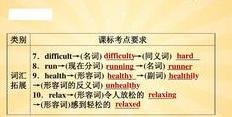一、现在分词怎么用run的现分词呢?
run的现在分词是:running。
现在分词的用法:
1.现在分词的形式:
否定式:not + 现在分词
(1)现在分词的主动语态:现在分词主动语态的一般式表示与谓语动词所表示的动作同时发生;完成式表示的动作在谓语动词所表示的动作之前发生,常作状语。
e.g.They went to the park, singing and talking.
他们边唱边说向公园走去。
Having done his homework, he played basket-ball.
做完作业,他开始打篮球。
(2)现在分词的被动语态:一般式(being done)表示与谓语动词同时发生的被动的动作,完成式(having been done)表示发生在谓语动词之前的被动的动作。
e.g.The problem being discussed is very important.
正在被讨论的问题很重要。
Having been told many times, the naughty boy made the same mistake.
被告诉了好几遍,这个淘气的孩子又犯了同一个错误。
2.现在分词的句法功能
(1)作定语:现在分词作定语,当分词单独做定语时,放在所修饰的名词前;如果是分词短语做定语放在名词后。
e.g.In the following years he worked even harder.
在后来的几年中,他学习更努力了。
The man speaking to the teacher is our monitor's father.
正与老师谈话的那个人是我们班长的父亲。
现在分词作定语相当于一个定语从句的句法功能,如:in the following years也可用in the years that followed, the man speaking to the teacher可改为the man who is speaking to the teacher.
(2)现在分词作表语:
e.g.The film being shown in the cinema is exciting.
正在这家上演的电影很棒。
The present situation is inspiring.
当前的形势鼓舞人心。
"be + doing"既可能表示现在进行时,也可能是现在分词做表语,它们的区别在于"be + doing"表示进行的动作是进行时,而表示特征时是系动词be与现在分词构成系表结构。
(3)作宾语补足语
以下动词后可跟现在分词作宾语补足语:see, watch, hear, feel, find, get, keep, notice, observe, listen to, look at, leave, catch等。
e.g.Can you hear her singing the song in the next room?
你能听见她在隔壁唱歌吗?
He kept the car waiting at the gate.
他让小汽车在门口等着。
(4)现在分词作状语
①作时间状语
e.g.(While) Working in the factory, he was an advanced worker.
在工厂工作时,他是一名先进工人。
②作原因状语
e.g.Being a League member, he is always helping others.
由于是共青团员,他经常帮助他人。
③作方式状语,表示伴随
e.g.He stayed at home, cleaning and washing.
他呆在家里,又擦又洗。
④作条件状语
e.g.(If) Playing all day, you will waste your valuable time.
要是整天玩,你就会浪费宝贵的时间。
⑤作结果状语:
e.g.He dropped the glass, breaking it into pieces.
他把杯子掉了,结果摔得粉碎。
⑥作让步状语
e.g.Though raining heavily, it cleared up very soon.
虽然雨下得很大,但不久天就晴了。
3.怎样使用现在分词独立结构作状语
如果分词的逻辑主语与句子主语不一致,可采用分词独立结构作状语。分词独立结构则:"名(代)词+现在分词"构成,可在句子中作状语,表示时间、原因、条件、伴随状况等。
e.g.Class being over, the children went home.
下课了,学生们回家去。
Nobody being in the room, I didn't go in.
由于房间里没有人,我没有进去。
Weather permitting, we'll start tomorrow.
如果天气允许,我们明天动身。
He went to the front door, his son following him.
他走向前门,他的儿子跟在后面。
4.注意固定结构的分词独立成分作状语:现在分词独立成分一般已形成固定结构,表示说话人对说话内容所持的态度或看问题的态度。
e.g.Generally speaking, we don't agree with you.
一般说来,我们不同意你的看法。
Considering his age, the child reads quite well.
鉴于他的年龄,这个孩子读得相当好。
Judging from what you say, he ought to succeed.
根据你所说的来看,他应当成功。
5.现在分词的完成式和被动式
(1)现在分词完成式,表示在句子谓语之前发生的动作和状态,现在分词的完成被动式,表示发生在谓语之前的一个被动动作,它们在句子中一般只作状语。
e.g.Having learnt a little English, he tried to talk to the English actress.
由于原先学了一点英语,他试图同那位英国女演员说话。
Having been given such a good chance, how could she let it slip away?
人家给了她这样一个机会,她怎么能轻易放过?
Having being used for many years, the machine needs repairing.
由于使用了多年,这台机器需要修理。
(2)现在分词一般被动式,表示分词动作和谓语动作同时发生或正在发生,可用来作定语、宾补或状语。
e.g.He asked who was the man being operated on. (作定语)
他问正在被动手术的那个人是谁。
When we got to the hall, we found the lecture being given by Professor Liu. (作宾补)
我们到达大厅时,发现刘教授正在作讲演。
Being protected by a thick wall, they felt they were very safe. (作状语)
由于有一堵墙掩护着,他们感到很安全。
6.区别动名词和现在分词:动名词和现在分词都是由v.-ing构成,在句中都能作表语和定语,而且都保留着动词的一些特征,有其完成式和被动态。那么v.-ing形式到底是现在分词还是动名词呢?下面有几种区别方法:
(1)如果v.-ing形式与被修饰名词逻辑上是主谓关系,就是现在分词,它相当于定语从句;如果逻辑上没有主谓关系,则是动名词,它可以用介词for加上这个动名词来代替,该介词短语应放在被修饰名词之后。e.g.
①a moving blackboard 正在移动的黑板
(moving:现在分词,a moving blackboard=a blackboard which is moving)
②a walking tractor 手扶拖拉机
(walking:现在分词,a walking tractor=a tractor which is walking)
③a swimming pool 游泳池
(swimming:动名词,a swimming pool=a pool for swimming)
④a walking stick 手杖
(walking:动名词,a walking stick=a stick for walking)
(2)如果v.-ing形式是说明主语怎么样,表示的是主语的形状、特征的是现在分词,现在分词起着形容词和副词的作用,在句中作宾补和状语,一般用how提问,后不带宾语,但可用very,so,quite等词修饰,也可用more和most分别构成比较级和最高级。
如果v.-ing形式是说明主语是什么,即主语的具体内容,强调主语的行为、功能和用途的则为动名词。
动名词起着名词的作用,在句中作主语和宾语,一般用what提问,也可用状语来修饰,但不能用程度副词very,much等修饰。
e.g.
①The news is very exciting.(exciting:现在分词)
②Laying eggs is her full-time job.(laying:动名词)
③This book is more interesting than that one.(interesting:现在分词)
(3)动名词作表语和主语间可以划等号,甚至可以交换位置。如上述例句②可改写成:Her full-time job is laying eggs.而现在分词充当表语,不能同主语划等号,因此不能同主语换位置。例句①不能改写成:Exciting is the news.
(4)v.-ing前有冠词、物主代词、名词所有格或指示代词的是动名词,用来构成v.-ing形式的复合结构。独立主格结构中所用的v.-ing形式的是现在分词。
e.g.His coming was unexpected.(coming:动名词)
The Chinese are brave and hard-working.(working:现在分词)
It being hot, we went to swim.(being:现在分词)
满意请采纳,谢谢!
二、识记疑问代词的方法?
1
疑问词的作用主要是用于引出特殊疑问句。其中疑问词在句中可用作主语、宾语、表语或定语等。
英语疑问句的词序通常为“疑问词+一般疑问句”。如:
What did you do with the money that was left? 你对剩下的钱是怎么处理的?
但若疑问词直接用作主语或修饰语语,则其词序为“疑问词+谓语+其他成分”。如:
What made you so frightened? 什么使你这样惊恐?
Who will attend on the patient? 谁来护理病人?
Which car was your original choice? 你原来选的是哪辆车?
指人的疑问代词
01
指人的疑问代词主要有who, whom, whose。其中who为主格,whom为宾语,whose为所有格。如:
Who is responsible for breaking the mirror? 是谁把镜子打破的?
Whom would you suggest for the job? 你提议由谁来做这工作?
Whose turn is it to treat next? 下次该谁请客?
指物的疑问代词
指物的疑问代词主要有what,它在句中可用作主语、宾语和定语等。如:
What is the total population of china? 中国的人口总数是多少?
What can I do in return for your kindness? 我怎样做才能报答你的好意呢?
What things happened after we left? 我们离开后发生了什么事?
既可指人也可指物的疑问代词
既可用来指人又可用来指物的疑问代词主要有which,它在句中可用作主语、宾语和定语。如:
Which doctor is attending you? 哪个医生在给你治疗?
Which judge is hearing the case? 哪个法官在审这个案子?
Which part of the concert did you like best [most]? 这场音乐会,哪一部分你最喜欢?
Which subjects are compulsory in your school? 在你们学校里,哪些课程是必修的?
Which events is he going in for at the Olympics? 他参加奥运会的什么项目?
三、admit用ing形式造句?
①
admit doing something 中文意思是“承认做过……”。
例如,在大量证据面前,他不得不承认自己一个人行窃史密斯家。
In front of plenty of evidence,he had to admit breaking into the Smith's
他最后向老师承认数学考试舞弊事实。
He admitted cheating in the maths exam in front of the teacher
②
动词admit的用法
1、 admit 作“准许进入”、“允许参加”解释。例如:
①Open the window to admit some fresh air.打开窗子透透新鲜空气。
②Such people shouldn’t be admitted to the Party.这样的人不能吸收入党。
2、 admit 可作“承认”解释,这时,其后可跟名词、动词的-ing形式、宾语从句或宾语+宾语补足语。例如:
(1)John admitted knowing little about the subject.约翰承认是他打碎了窗子。
(2)The boy admitted that he had broken the window.
那男孩承认是他打碎了窗子。
(3)You must admit the work to be difficult.你应当承认这项任务是艰巨的。
【注意】admit 后可接不定式作宾补,但不可接不定式作宾语,如例句(3)。
3、 admit of : 作“容许”解。如:
(1)This is a universal truth which admits of no exception.
这是一条毫无例外的普遍真理。
4、 admit to : 承认。
(1) I must admit to being ashamed for what had happened.
发生这样的事我应承认我感到惭愧。
admitting
He showed great courage by admitting that he is an alcoholic. 他以极大的勇气承认自己酗酒。
四、admit的用法结构?
动词admit的用法:
1、 表示“承认”,注意以下用法: (1) 表示“承认做了某事”,其后通常接动名词不接不定式。
如: She admitted having seen us. 她承认看到过我们。
I admit breaking the window. 我承认打破了窗子。
表示“承认”时,有时用于 admit to, 此时的 admit为不及物动词,但该结构中的介词 to 常可省略,省略介词后 admit 即为及物动词。
如: He would never admit to being wrong. 他从不认错。
He admitted (to) stealing. 他供认了偷盗。
(2) 有时其后接带不定式的复合宾语,但其中的不定式通常应是 to be。
如: She admitted him to be right. 她承认他是对的。
You must admit the task to be difficult. 你们得承认任务是艰巨的。
(3) 有时可后接从句。
如: I admit (that) I was wrong(=I admit my mistake). 我承认我错了。
2、 表示“允许进入”、“使能进入”,可指进入某一具体场所也可指进入某一组织机构等。
如: This ticket admits one person only. 此券只准一人入场。
There were no windows to admit air. 没有窗子可使空气流入。
The school admits 200 students every year. 这所学校每年招收200名学生。
试比较以下两句(注意介词不同)。
如: She was admitted to [into] the Party. 她被吸收入党。
She was admitted as a Party member. 她被接纳为党员。
表示“允许进入”等,也含有动态意味,所以一般不与 enter, go in 之类的词连用。
如: 通常不说:He opened the door and admitted me to enter into the house. (可将 to enter 去掉)

